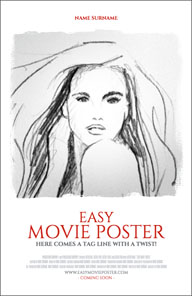Lights, Camera, AI: Crafting Cinematic Magic with AI Movie Poster Generators
Lights, Camera, AI: Crafting Cinematic Magic with AI Movie Poster Generators
Blog Article

In the ever-evolving landscape of filmmaking, the fusion of technology and creativity has given rise to tools that redefine how we promote and showcase cinematic experiences. One of the most exciting innovations in this realm is the AI movie poster generator. These powerful applications harness the capabilities of artificial intelligence to craft stunning visuals that capture the essence of a film, often in a fraction of the time it would take a traditional graphic designer.
Gone are the days when creating a captivating movie poster required extensive artistic training and hours of painstaking design work. Today, filmmakers and marketers can leverage AI movie poster generators to produce eye-catching promotional materials with just a few clicks. This not only streamlines the marketing process but also opens up new possibilities for independent filmmakers and smaller studios, allowing them to compete with the big names in the industry. As we delve deeper into this fascinating topic, we will explore how AI technology is shaping the future of movie poster design and what it means for the world of cinema.
The Technology Behind AI Movie Poster Generators
AI movie poster generators utilize advanced machine learning algorithms to create stunning visuals that captivate audiences. At the core of this technology is a class of neural networks known as generative adversarial networks, or GANs. GANs consist of two main components: a generator that creates images and a discriminator that evaluates them. The interplay between these two components allows the system to learn from errors and improve over time, resulting in high-quality and imaginative poster designs.
Film poster design tool no registration
Natural language processing plays a crucial role in these generators as well. By interpreting text descriptions or prompts provided by users, the AI can generate visuals that align with the themes and elements described. This enables filmmakers and marketers to explore various artistic styles and concepts without needing extensive graphic design skills. The integration of user inputs with visual datasets shapes the output, making each generated poster unique and tailored to specific requirements.
Moreover, AI movie poster generators often incorporate style transfer techniques, which allow the merging of different artistic styles. By analyzing existing movie posters and artworks, these generators learn what elements work best together—such as colors, fonts, and imagery. This not only enhances the aesthetic appeal of the generated posters but also ensures that they resonate with established cinematic trends, thereby helping to create compelling promotional material for films.
Creative Applications of AI in Movie Poster Design
The advent of AI movie poster generators has transformed the way filmmakers and designers approach promotional artwork. By utilizing machine learning algorithms, these tools can analyze vast datasets of existing movie posters and identify successful design elements. This allows creators to generate striking visuals that capture the essence of a film while still tapping into patterns that have historically resonated with audiences. The ability to iterate quickly on different design concepts aids in streamlining the creative process, enabling teams to explore a plethora of styles and themes before settling on a final product.
Additionally, AI movie poster generators excel in personalizing designs for targeted demographics. By leveraging data about viewer preferences, these generators can create posters that appeal specifically to certain audience segments. For example, a generator can adjust color schemes, imagery, and typography based on the traits most attractive to specific age groups or cultural backgrounds. This level of customization not only enhances marketing effectiveness but also fosters a deeper connection between the film and its potential viewers.
Furthermore, AI technology can facilitate collaborative efforts among creative teams by providing a common platform for brainstorming and visualization. Designers can combine their artistic instincts with AI-generated suggestions, which can lead to unexpected and innovative outcomes. The fusion of human creativity and machine intelligence encourages a rethinking of traditional design boundaries and inspires filmmakers to explore new narratives and aesthetics. This synergy ultimately results in movie posters that are not only visually appealing but also reflective of the film’s themes and messages.
Future Trends in AI-Powered Film Marketing
As the film industry continues to embrace technological advancements, AI movie poster generators are paving the way for innovative marketing strategies. These tools are becoming increasingly sophisticated, utilizing deep learning algorithms to analyze viewer preferences and market trends. This means that filmmakers and marketers can create highly personalized posters that resonate with specific target audiences, increasing engagement and interest in their films.
Moreover, the integration of AI in film marketing extends beyond just poster creation. We can expect to see AI-driven analytics shaping the entire marketing campaign, allowing studios to predict which visual elements will attract more viewers. With data-driven insights, marketers can tailor promotional materials not only to the film's themes but also to current societal trends and viewer sentiment, ensuring their marketing strategies are timely and effective.
Finally, as audience engagement continues to evolve, AI movie poster generators are likely to incorporate interactive elements. Future posters may feature augmented reality components or QR codes that lead to exclusive content, such as behind-the-scenes footage or interactive trailers. This shift towards a more immersive marketing experience will enhance viewer connection and anticipation, redefining how films are promoted in an increasingly digital landscape.
Report this page